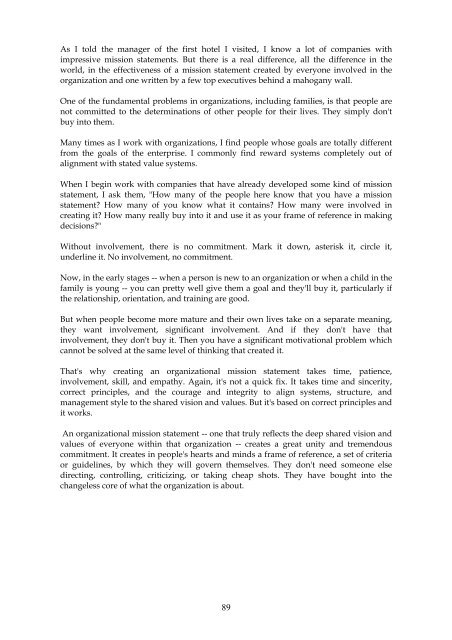Covey - The 7 habits of highly effective people
You also want an ePaper? Increase the reach of your titles
YUMPU automatically turns print PDFs into web optimized ePapers that Google loves.
As I told the manager <strong>of</strong> the first hotel I visited, I know a lot <strong>of</strong> companies with<br />
impressive mission statements. But there is a real difference, all the difference in the<br />
world, in the <strong>effective</strong>ness <strong>of</strong> a mission statement created by everyone involved in the<br />
organization and one written by a few top executives behind a mahogany wall.<br />
One <strong>of</strong> the fundamental problems in organizations, including families, is that <strong>people</strong> are<br />
not committed to the determinations <strong>of</strong> other <strong>people</strong> for their lives. <strong>The</strong>y simply don't<br />
buy into them.<br />
Many times as I work with organizations, I find <strong>people</strong> whose goals are totally different<br />
from the goals <strong>of</strong> the enterprise. I commonly find reward systems completely out <strong>of</strong><br />
alignment with stated value systems.<br />
When I begin work with companies that have already developed some kind <strong>of</strong> mission<br />
statement, I ask them, "How many <strong>of</strong> the <strong>people</strong> here know that you have a mission<br />
statement? How many <strong>of</strong> you know what it contains? How many were involved in<br />
creating it? How many really buy into it and use it as your frame <strong>of</strong> reference in making<br />
decisions?"<br />
Without involvement, there is no commitment. Mark it down, asterisk it, circle it,<br />
underline it. No involvement, no commitment.<br />
Now, in the early stages -- when a person is new to an organization or when a child in the<br />
family is young -- you can pretty well give them a goal and they'll buy it, particularly if<br />
the relationship, orientation, and training are good.<br />
But when <strong>people</strong> become more mature and their own lives take on a separate meaning,<br />
they want involvement, significant involvement. And if they don't have that<br />
involvement, they don't buy it. <strong>The</strong>n you have a significant motivational problem which<br />
cannot be solved at the same level <strong>of</strong> thinking that created it.<br />
That's why creating an organizational mission statement takes time, patience,<br />
involvement, skill, and empathy. Again, it's not a quick fix. It takes time and sincerity,<br />
correct principles, and the courage and integrity to align systems, structure, and<br />
management style to the shared vision and values. But it's based on correct principles and<br />
it works.<br />
An organizational mission statement -- one that truly reflects the deep shared vision and<br />
values <strong>of</strong> everyone within that organization -- creates a great unity and tremendous<br />
commitment. It creates in <strong>people</strong>'s hearts and minds a frame <strong>of</strong> reference, a set <strong>of</strong> criteria<br />
or guidelines, by which they will govern themselves. <strong>The</strong>y don't need someone else<br />
directing, controlling, criticizing, or taking cheap shots. <strong>The</strong>y have bought into the<br />
changeless core <strong>of</strong> what the organization is about.<br />
89


